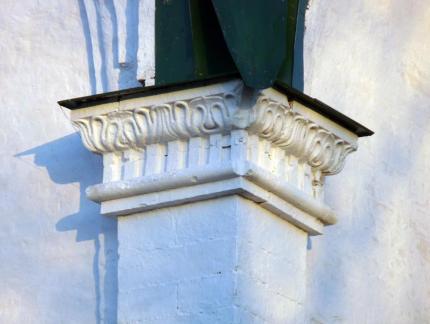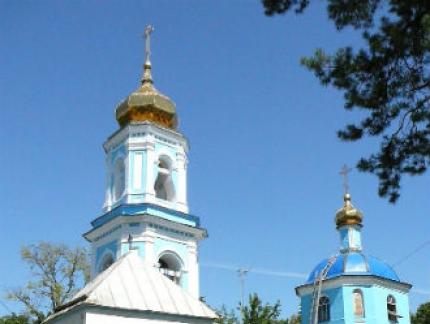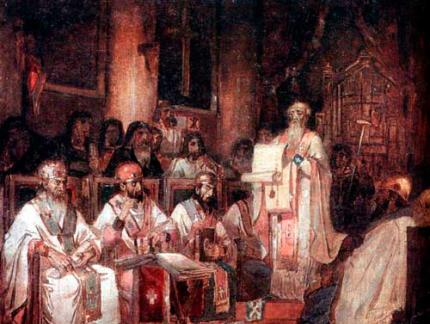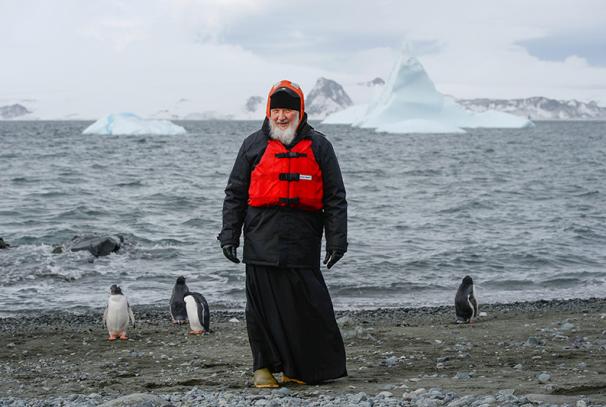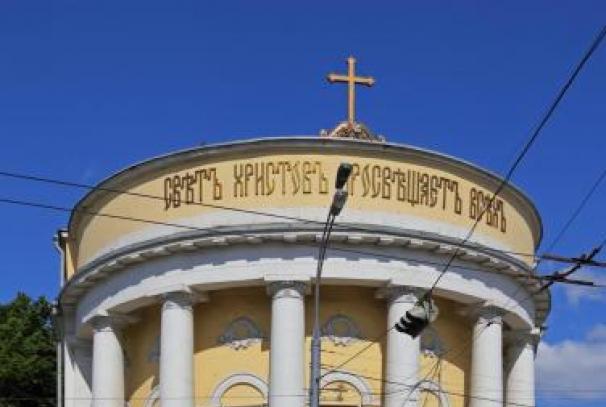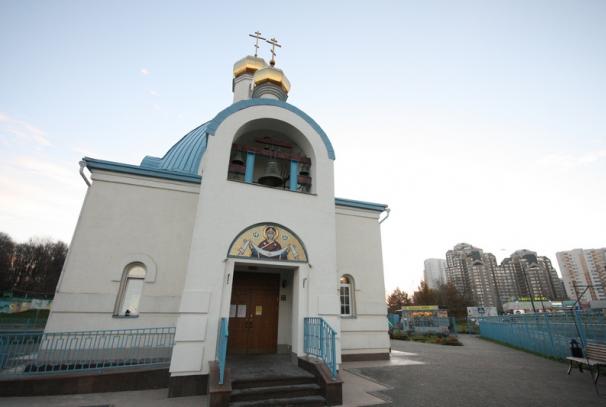The temple of the holy martyrs of faith, hope, love and the wise mother of their sophia. Temple of the Holy Martyrs of Faith, Hope, Love and the Wise Mother of Theirs Sofia Temple of the Faith of Hope of Love and Their Mother
The temple belongs to the Trinity Deanery of the Moscow Diocese of the Russian Orthodox Church. First, on the site of a stone church, there was a wooden church, consecrated on January 20, 1773 in honor of one of the patrons of Catherine II, according to the vow given to her during the coronation, to build temples in Moscow in honor of Saints Catherine, Sofia, and saints, on whose memorial day the coronation took place. In 1823 on the site of a wooden temple they build a stone temple in the Empire style. Funds for the construction were allocated by the merchant of the first guild Ivan Petrovich Kozhevnikov. In 1834 the chapels of the Icon of the Mother of God “Sign” and St. Metrophanes of Voronezh were attached to the church. Later, from the western facade, two single-tier belfries were erected above the aisles. Later, with the funds of the ensign A.A. Neronova’s guard, a four-tier bell tower, an almshouse and a refectory were expanded (the northwestern and southwestern corners were added). In the early 1920s, St. Tikhon the Patriarch of All Russia served repeatedly in the church. From 1934 to 1990, the temple was closed, and on its territory was located the equipment shop "Medical allowance" of the Ministry of Health of the RSFSR. In 1990 the church was returned to the Russian Orthodox Church and divine services were resumed in it.
At the Miussky cemetery, founded in 1771 during the plague epidemic near the Miussa area (hence the name)., In 1773 a wooden church was built and consecrated according to the vow given by Catherine II on the day of the coronation. The coronation took place on the day of memory of Catherine, Sofia, and other saints, in connection with which the church was consecrated in honor of Faith, Hope, Love and their mother Sofia. In 1823, at the expense of the merchant I.P. Kozhevnikov, a stone in the Empire style was built in place of the wooden one (architect A.F. Elkinsky). In the years 1834-1835 the chapels of the Sign and St. Mitrofan Voronezhsky - at the expense of the Ensign Alexandra Abramovna Neronova. The rite of consecration of the temple was performed by St. Philaret (Drozdov), Metropolitan of Moscow and Kolomna. Later, from the western facade over the aisles, symmetrically to the main axis of the temple, two single-tier belfries were erected. In 1912, with the funds of the Ensign A. A. Neronova’s guard, the four-tier bell tower was rebuilt, the refectory was expanded, the northwestern and southwestern corners were added, and an almshouse was opened at the temple. In the early 1920s, St. Tikhon (Bellavin), the All-Russian Patriarch, repeatedly served in the church. In 1922, church values \u200b\u200bwere removed from the surviving churches and monasteries. The ruin of the temple at the Miussky cemetery occurred on April 5, 1922, during the campaign to seize church property, “4 pounds 4 pounds 25 gold and silver spools” were withdrawn from the temple. On January 1, 1933 in the church of St. Faith, Hope, Love and their mother Sophia in the Miussky cemetery were renovated. In 1934 the temple was closed, the cross was knocked down from it, the bell tower was broken to the first tier. An ugly extension was made behind the apse, on the sides of the dome and above the refectory. The building of the temple housed the equipment workshop "Medical allowance" of the Ministry of Health of the RSFSR. Until 1990, the temple was closed and rebuilt for civilian premises, the bell tower was destroyed to the first tier. The church was returned to the Russian Orthodox Church in 1990, and since September 28, services have been resumed here. The architectural and artistic appearance of the temple of the early twentieth century was recreated. The roof was replaced, which is now completely covered with copper, the icons in the icon cases took their place in the temple, the walls are painted. On March 14, 2012, by the decree of the Patriarch of Moscow and All Russia Kirill, a representative office of the Metropolitan District of the Russian Orthodox Church in the Republic of Kazakhstan was opened at the church. The church has a Sunday school, a library. Shrines: the revered icon of the Mother of God “The Naughty”; the venerated icon of the Mother of God “Theodorovskaya”; venerated icon of st. mzz. Faith, Hope, Love and Sophia with relics; particle relics prp. Sevastian of Karaganda, Spanish; particle relics of st. mch. Seraphim and Theognostus of Almaty. The temple is open from 9 to 18 hours.
Temple in honor of the holy martyrs Faith, Hope, Love and their mother Sophia in Chertanov
ADDRESS:South Administrative District. St. Podolsky Cadets, ow. 7
PRESIDENT RESPONSIBLE FOR CONSTRUCTION: Priest Mikhail Karpenko, clergyman of the Church of St. Nicholas of Myra in Biryulev
PROJECT ORGANIZATION:UniStroyProekt
Official website of the parish: hram-vnls.ru
STAGES OF CONSTRUCTION:
May 2019project architect Denis Anatolyevich Rimsha said: “Inside, the temporary temple is well-maintained, but outside it is necessary to ennoble the facades, harmoniously combine disparate buildings, and give the complex the appearance of a finished architectural composition.”
March 2019:work is underway on interior decoration.
January 2019an extension to the temple is being carried out, which will double the area of \u200b\u200bthe prayer hall.
The forces of believers in the temporary temple completed the work on the interior decoration. Icons are hung on the walls. The small church is very cozy and warm.
Fall 2015 years on the temporary temple were raised dome and cross.
March 22, 2015 At the site of the construction of the temple a Poklonnaya Cross was erected.
“All construction work is done at the expense of the community and philanthropists,” says the abbot. - However, there are not enough funds. We understand that this is not an easy time. But we ask everyone who has such an opportunity to make their contribution to the building of the House of God. We will be glad and grateful for any help! Any support is important to us: your prayers, efforts to disseminate information, make donations and help with building materials. God bless all! ”
Requisites:
| Payment receiver: | Religious organization “Compound of the Patriarch of Moscow and All Russia at the Church of the Holy Martyrs Faith, Hope, Love and their Mother Sophia in Chertanov Central, Moscow, Russian Orthodox Church (Moscow Patriarchate)” |
| TIN / PPC of the recipient: | - |
| Beneficiary Account Number: | 40703810138000004754 |
| Name of beneficiary's bank: | Sberbank of Russia PJSC, Moscow |
| BIC: | 044525225 |
| Beneficiary bank account number: | 30101810400000000225 |
| Payment Description: | For the temple of father Mikhail Karpenko |
Parish News:
Two new temple projects are planned to be obtained from the examination in May (Meeting in the Cathedral of Christ the Savior)

Faith, Hope, Love and their mother Sofia
The feat of standing in the faith of these martyrs was revealed to the human race many centuries ago to strengthen all subsequent generations of Christians. May this feat strengthen us, modern Christians.
The holy martyrs Faith, Hope and Love were born in Italy. Their mother, Saint Sophia, was a devout Christian widow. Calling her daughters the names of three Christian virtues, Sophia raised them in love for the Lord Jesus Christ. During the time of persecution of Christians, Sofia and her daughters did not hide their faith in Christ and openly confessed it to everyone. The governor Antiochus informed the emperor Hadrian (117 - 138), and he ordered the righteous to be brought to Rome.
When the holy virgins appeared before the emperor, all those present were amazed at their calmness: it seemed that they were called to a bright celebration, and not to torture. Calling the sisters in turn, Adrian urged them to make a sacrifice to the goddess Artemis. Young virgins (Vera was 12, Nadezhda - 10, and Lyubov - 9 years old) remained adamant. Then the emperor ordered to cruelly torture them: they burned the holy girls on an iron grate, threw them into a hot furnace and into a boiler with boiling tar, but the Lord kept them with His Invisible Force.
The youngest, Love, was tied to a wheel and beaten with sticks until her body turned into a continuous bloody wound. Bearing unprecedented torment, the holy virgins glorified their Heavenly Bridegroom and remained unshakable in faith. Hagia Sophia was subjected to a different, more severe torture: the mother was forced to look at the suffering of her daughters. But she showed extraordinary courage and all the time urged the girls to endure torment in the Name of Heavenly Groom to the end.
All three girls happily met their martyrdom. Finally, they were beheaded. To prolong the spiritual suffering of St. Sophia, the emperor allowed her to take the bodies of her daughters. Sofia put their remains in the ark and drove away with honors in a chariot outside the city, where she buried in a high place. For three days, Saint Sophia sat at the graves of her daughters and, finally, betrayed her soul to the Lord. Believers buried the body of the saint in the same place. The relics of the holy martyrs from 777 rest in the north-east of France in Alsace, in the church of Echo.
The Day of the Holy Martyrs Faith, Hope, Love and Sophia is celebrated by the Orthodox Church on September 30. On this day, the patronal feast of the future temple will be lightly celebrated. And may every year, especially on the throne, the temple be filled with infants and youths, brought by pious parents to the inexhaustible source of grace - the Lord and Our Savior Jesus Christ.
Date of creation: 1823 Description:History
The Miussky treasure-bishop was discovered in 1771 during the epi-de-mission of the Chu-we. In 1773, the first de-re-vyan temple was built here.
In 1823, on the site of a wooden building on the medium of the merchant I.P. Ko-zhev-ni-ko-va was built-up-not-so-so-so-so-so-so-on-stone temple (architect A.F. El-kin-sky). The consecration was performed by Metropolitan of Moscow Filaret (Drozdov).
In 1834, chapels were added to the church in honor of the Icon of the Mother of God “The Sign” and St. Mitrofan of Voronezh. Later, from the western facade, two single-tier belfries were erected above the aisles. In the years 1911-12. on the medium of A.A. Ne-ro-no-howl in a simple manner-ko-lo-kol-nya and bo-ha-del-nya.
In the early 1920s In the temple, he repeatedly co-served with worship. T-hon, Pat-ri-arch of Moscow and All Russia.
In 1934 the temple was closed, the cross was shot down, the number of Kolya was destroyed to the first tier, the building of the temple was subsequently re-built.
God-he-same-do-it-yourself-nov-le-ny 28 Sep-tyab-rya 1990. Under the direction of the rector of the church Archpriest Boris Prisyazhnyuk (+2011), the architectural and artistic appearance of the temple of the early twentieth century was recreated. The roof was replaced, the walls were painted, the icons were placed in icon cases.
The Church owns the church by order of the Moscow City Property Department of February 10, 2017.

